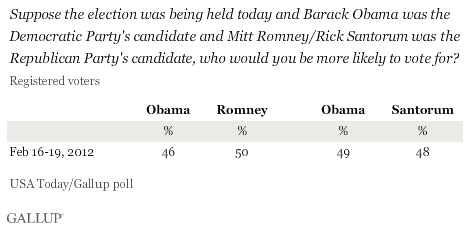PRINCETON, NJ -- U.S. registered voters are closely divided in their 2012 presidential election preferences between Barack Obama and Mitt Romney, and between Obama and Rick Santorum. Romney is slightly ahead of Obama, 50% to 46%, while Obama edges Santorum, 49% to 48%, but neither of these differences is statistically significant.

Santorum and Romney are the current leaders in the volatile Republican primary race. In Gallup Daily tracking conducted Feb. 17-21, 35% of Republican voters nationwide support Santorum, compared with 27% for Romney, 15% for Newt Gingrich, and 10% for Ron Paul.
Santorum's competitive position against Obama in the Feb. 16-19 data represents an improvement compared with interviewing conducted Jan. 27-28, when Obama led Santorum by eight percentage points, 51% to 43%. At that time, Santorum was still trailing both Romney and Gingrich in Gallup's tracking of Republican preferences for their party's nomination. After his Feb. 7 wins in Minnesota, Colorado, and Missouri, Santorum surged to a 10-point lead over Romney. He continues to lead the race among Republicans nationally, and may now be more competitive with Obama among all U.S. voters as a result.
![Suppose the election was being held today and Barack Obama was the Democratic Party's candidate and Rick Santorum was the Republican Party's candidate, who would you be more likely to vote for -- [ROTATED: Barack Obama, the Democrat (or) Rick Santorum, the Republican]? February 2012 results](http://content.gallup.com/origin/gallupinc/GallupSpaces/Production/Cms/POLL/n4j4nxpipes6apzcftflla.gif)
The Obama versus Romney results are not significantly different from previous USA Today/Gallup polls, or from previous measures included on the Gallup Daily tracking survey. The gap between Obama and Romney across all previous measures has varied between zero and four points, none of which is statistically significant.
![Trend: Suppose the election was being held today and Barack Obama was the Democratic Party's candidate and Mitt Romney was the Republican Party's candidate, who would you be more likely to vote for -- [ROTATED: Barack Obama, the Democrat (or) Mitt Romney, the Republican]?](http://content.gallup.com/origin/gallupinc/GallupSpaces/Production/Cms/POLL/ixnkqe0c2ki09407m4msbw.gif)
The next major campaign event after Wednesday night's Republican debate in Arizona will be the Feb. 28 primaries in Michigan and Arizona. The results of those contests will affect the relative standing and images of Romney and Santorum, which could in turn affect their positioning against Obama in hypothetical trial heat match-ups. At the moment, however, both Republican candidates would find themselves in a close race with the president if the election were held today.
Track every angle of the presidential race on Gallup.com's Election 2012 page.
Survey Methods
Results for this USA Today/Gallup poll are based on telephone interviews conducted Feb. 16-19, 2012, with a random sample of 898 registered voters, aged 18 and older, living in all 50 U.S. states and the District of Columbia.
For results based on the total sample of registered voters, one can say with 95% confidence that the maximum margin of sampling error is ±4 percentage points.
Interviews are conducted with respondents on landline telephones and cellular phones, with interviews conducted in Spanish for respondents who are primarily Spanish-speaking. Each sample includes a minimum quota of 400 cell phone respondents and 600 landline respondents per 1,000 national adults, with additional minimum quotas among landline respondents by region. Landline telephone numbers are chosen at random among listed telephone numbers. Cell phone numbers are selected using random-digit-dial methods. Landline respondents are chosen at random within each household on the basis of which member had the most recent birthday.
Samples are weighted by gender, age, race, Hispanic ethnicity, education, region, adults in the household, and phone status (cell phone only/landline only/both, cell phone mostly, and having an unlisted landline number). Demographic weighting targets are based on the March 2011 Current Population Survey figures for the aged 18 and older non-institutionalized population living in U.S. telephone households. All reported margins of sampling error include the computed design effects for weighting and sample design.
In addition to sampling error, question wording and practical difficulties in conducting surveys can introduce error or bias into the findings of public opinion polls.
View methodology, full question results, and trend data.
For more details on Gallup's polling methodology, visit www.gallup.com.
